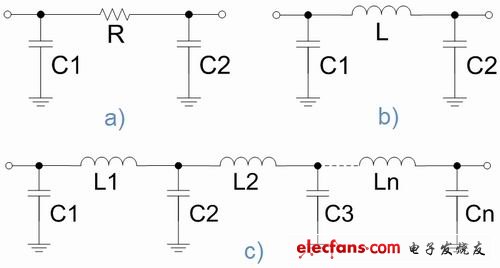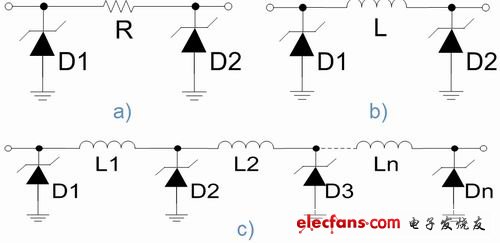Common EMI/RFI filter types and filtering requirements
For EMI/RFI filters, the most common architecture is the "Pi" filter. As the name implies, this architecture is similar to the Greek letter "π". There are two common π-type filters, namely CRC (capacitor-resistance-capacitor) filter and CLC (capacitor-inductor-capacitor) filter. Among them, the CRC filter (see Figure 1a) is also called RC-π filter or π-type RC filter for audio and low-speed data filtering applications; CLC filter (see Figure 1b) is also called LC-π filter Or π-type LC filters for audio, low-speed and high-speed data filtering applications.
There is also an extended type of π-type filter, a ladder-shaped filter shaped like a ladder, the most common of which is the LC (inductance-capacitor) ladder filter (see Figure 1c), which accepts higher data rates, but As filter components (inductors or capacitors) increase, size and cost can become a problem, resulting in higher material costs and larger packages.

Figure 1: Schematic diagram of the common EMI/RFI filter types: a) π-type RC; b) π-type LC; c) LC trapezoid.
Among these types of EMI/RFI filters, the π-type RC filter has the widest transition band (transiTIon band) and the lowest rolloff rate from the comparison of the amplitude-frequency response; the transition rate of the π-type LC filter Lower, but the transition band is moderate; the ladder filter can achieve extremely high turning rates and narrow transition bandwidth.
In the case of EMI/RFI filtering, for mobile phone applications, a traditional reference frequency is 800 MHz because 800 MHz is close to the starting frequency of the band used by the handset. In most cases, cell phone design engineers require filtering at frequencies above 800 MHz, which typically means a minimum of 30 dB of signal attenuation. As the functionality in mobile phones increases and the clock and data signals are classified, the reference frequency is decreasing. Many portable electronics manufacturers require EMI/RFI filtering at 400 MHz, and EMI/RFI filtering at lower frequencies may be required in the future.
Integrated EMI filtering and ESD protection
In portable products, the filter is typically located adjacent to the connection port, microphone, and Speaker. And these locations may also face electrostatic discharge (ESD) events. Taking an audio line as an example, if a discrete component scheme is used to separately perform EMI filtering and ESD protection, the number of components required to perform these two functions is faced. Among them, in the case of an EMI filter, if one discrete π-type LC filter is used, two surface mount capacitors and one surface mount inductor are required. In order to provide ESD protection, an additional type of surface mount transient voltage suppressor (TVS) diode is required. In this way, EMI filtering and ESD protection of one audio line requires four separate components, and there is no mention of the precious space problem of the portable devices required for these components. If there is more than one audio line, then it is even more impractical to use a discrete component solution.
Therefore, the simplest solution is to integrate EMI filtering and ESD protection in the same component. First, the integrated TVS diode in the integrated solution also provides the capacitance required for EMI filtering. Second, the improved process technology can also significantly improve the quality of the integrated inductor. By integrating these integrated components onto silicon, an integrated EMI filter + ESD protection scheme can be used (see Figure 2).

Figure 2: Integrated EMI filtering + ESD protection scheme: a) π-type RC; b) π-type LC; c) LC trapezoid.
Among them, in terms of ESD protection level, the IEC61000-4-2 standard specifies system-level test conditions and protection levels. This level is divided into four types. Portable applications usually require level 4 protection, that is, at 8 kV contact discharge or Under the test conditions of 15 kV air discharge IEC61000-4-2, portable devices need to be able to withstand the impact of ESD events.
Overall, by cost-effectively integrating EMI filtering and ESD protection, portable application designers can reduce costs, reduce the number of bill of materials (BOM) components, and reduce board space.
With 15+ years manufacturing experience for phone accessories.
Supply various portable charger for iPhone, Airpods, laptop, radio-controlled aircraft ,laptop, car, medical device, mobile device, ect.
Avoiding your devices run out of charge, portable chargers to keep your mobile device going.
From the original ordinary power bank charger to wireless power bank, green energy solar power bank, magnetic mobile power, Portable Power Stations and other products continue to innovate.
We help 200+ customers create a custom mobile power banks design for various industries.
Portable Charger,Power Bank Charger,Mini Power Bank,Wireless Power Bank, Solar Power Bank
TOPNOTCH INTERNATIONAL GROUP LIMITED , https://www.mic11.com